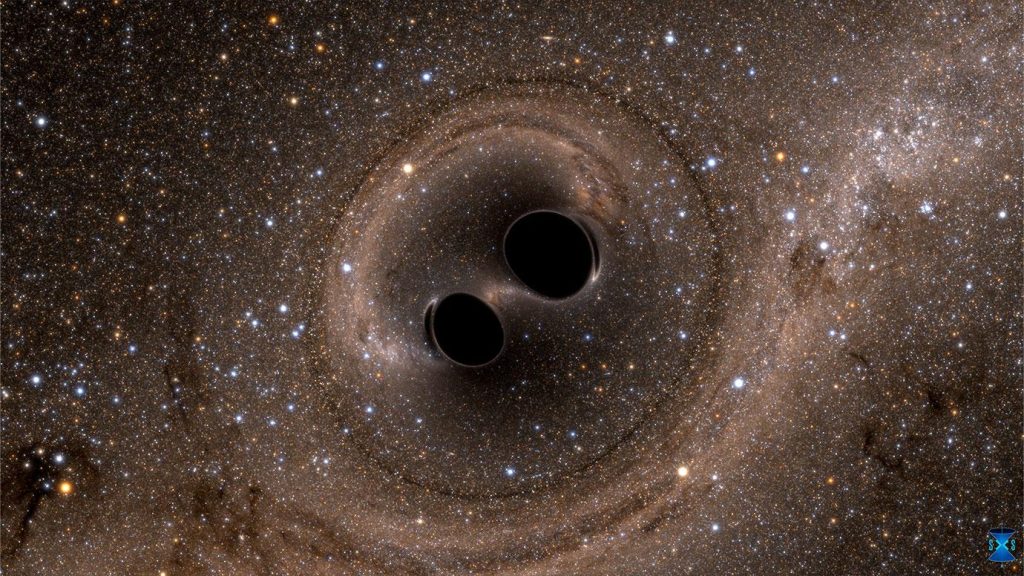Black holes, the enigmatic cosmic entities where gravity reaches its ultimate extreme, have fascinated scientists and the public alike since their theoretical prediction over a century ago. These mysterious objects are formed from the remnants of massive stars, collapsing under their own gravity to create regions of space where nothing, not even light, can escape. When two black holes merge, they produce an event of unimaginable violence, emitting powerful ripples in the fabric of space-time known as gravitational waves. In this article, we will explore the thrilling world of black hole collisions, delve into the groundbreaking techniques used to detect these elusive gravitational waves, and discuss the transformative impact of this research on our understanding of the universe.
The Dance of Black Holes
Black holes are not solitary wanderers drifting aimlessly through the cosmos; they often reside in binary systems, pairs of black holes orbiting around each other due to their mutual gravitational attraction. As these binary systems evolve over billions of years, the black holes gradually spiral closer together, eventually culminating in a cataclysmic merger.
The final moments before the merger are marked by a frenzied dance of gravitational interactions, where the black holes spiral inward at a significant fraction of the speed of light. This violent cosmic ballet releases an enormous amount of energy in the form of gravitational waves, which propagate outward through space, carrying with them information about the cataclysmic event that produced them.
The Hunt for Gravitational Waves
Detecting gravitational waves is one of the most challenging endeavors in astrophysics, requiring extraordinary precision and sensitivity. Unlike electromagnetic waves, such as light or radio waves, gravitational waves interact very weakly with matter, making them extremely difficult to detect directly. However, the information they carry about the universe’s most energetic events, such as black hole mergers, makes them invaluable tools for probing the cosmos.
The Laser Interferometer Gravitational-Wave Observatory (LIGO), a collaborative project involving scientists from around the world, pioneered the field of gravitational wave astronomy with its groundbreaking discoveries in 2015. LIGO consists of two identical detectors located in the United States, each equipped with laser interferometers capable of measuring minuscule changes in the distance between mirrors caused by passing gravitational waves.
The First Detection: A New Era in Astronomy
On September 14, 2015, LIGO made history by detecting gravitational waves from the merger of two black holes located over a billion light-years away. This monumental discovery, announced in 2016, confirmed a key prediction of Einstein’s theory of general relativity and opened a new window into the universe, allowing scientists to observe cosmic phenomena previously invisible to traditional telescopes.
The gravitational wave signal, named GW150914, provided a wealth of information about the black holes involved in the merger, including their masses, spins, and the energy released during the collision. The event marked the beginning of gravitational wave astronomy, a revolutionary field that promises to transform our understanding of black holes, neutron stars, and the fundamental nature of gravity itself.
Advancements and New Discoveries
Since the landmark detection in 2015, LIGO and its European counterpart, Virgo, have continued to observe numerous gravitational wave events, including additional black hole mergers and the first-ever detection of a neutron star merger in 2017. These observations have provided unprecedented insights into the dynamics and properties of compact astrophysical objects, shedding light on the mysteries of their formation, evolution, and interactions.
The wealth of data collected by gravitational wave detectors has also enabled scientists to test the predictions of general relativity with unprecedented precision, probing the limits of our current understanding of gravity and potentially uncovering hints of new physics beyond Einstein’s theory.
Future Prospects and Cosmic Frontier
As gravitational wave astronomy continues to mature, future advancements in detector technology and data analysis techniques promise to unlock even more profound insights into the universe’s most extreme phenomena. Planned upgrades to LIGO and Virgo, as well as the development of new detectors such as the Laser Interferometer Space Antenna (LISA), a space-based gravitational wave observatory, will expand the reach and sensitivity of gravitational wave detectors, opening up new avenues for discovery and exploration.
These advancements could lead to the detection of previously unobserved cosmic events, such as the mergers of intermediate-mass black holes or the remnants of primordial black holes from the early universe. They could also provide crucial insights into unresolved questions in astrophysics, cosmology, and fundamental physics, shaping our understanding of the cosmos for generations to come.
Conclusion
Black hole collisions and the detection of gravitational waves represent a new frontier in astronomy, offering unprecedented opportunities to explore the universe’s most extreme and enigmatic phenomena. The groundbreaking discoveries made by LIGO and other gravitational wave observatories have revolutionized our understanding of black holes, gravity, and the nature of the universe itself, paving the way for future advancements and discoveries.
As scientists continue to push the boundaries of what is possible with gravitational wave astronomy, we stand on the brink of a new era in our quest to unravel the mysteries of the cosmos. The collision of black holes, once invisible and silent, now resonates with the symphony of the universe, revealing the hidden rhythms and harmonies of the cosmos and inspiring wonder and awe in the hearts and minds of all who gaze upon the night sky.
Read More: The Fermi Bubbles: Giant Structures at the Center of the Milky Way
